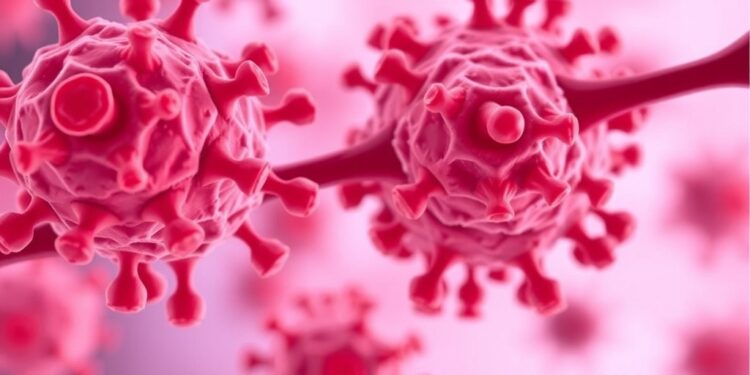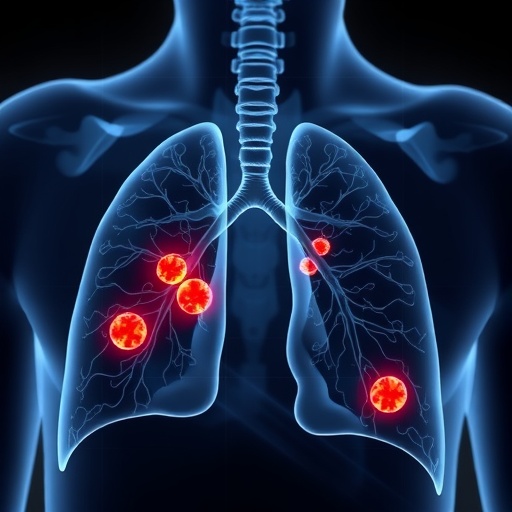
In a groundbreaking study published in Cancer Immunology Research, Dr. Russell W. Jenkins and his team have unveiled a novel approach to enhancing chimeric antigen receptor T-cell therapy, particularly in its application to solid tumors. The study, which identifies TBK1 (TANK-binding kinase 1) as a significant target for therapeutic enhancement, aims to overcome the well-documented limitations of CAR-T therapy when applied to solid tumors. Dr. Jenkins, a leading physician investigator at the Krantz Family Center for Cancer Research at the Mass General Cancer Center, is lauded for shedding light on the intricate factors contributing to treatment resistance against CAR-T therapies.
Chimeric antigen receptor T-cell therapy has revolutionized treatment for hematological malignancies, but its efficacy in solid tumors has been severely constrained. The complexity of the tumor microenvironment poses significant challenges, leading to an urgent need for innovative strategies that can enhance treatment outcomes. The research focuses on the interaction between engineered T-cells and solid tumors, which has historically led to disappointing results despite initial promise. In light of these challenges, the team developed a unique experimental model utilizing patient-derived organotypic tumor spheroids, or PDOTS, which mimic the native tumor architecture. This model allows for a more accurate representation of how CAR-T cells interact with solid tumors in a controlled environment.
The study aims to unravel key mechanisms behind the tumor’s resistance to CAR-T cell therapy, particularly those related to the expression of immune checkpoint receptors on T-cells upon their first exposure to tumor cells. This interaction has revealed that T-cells become dysfunctional and growth-inhibited after their initial attack, significantly undermining their therapeutic effectiveness. Such findings underscore the complexity of the immune response and the need for multifaceted approaches to rebuild T-cell functionality when confronted with solid tumors.
One of the remarkable aspects of this research is the identification of TBK1 as a critical regulator of T-cell functionality. By manipulating TBK1 expression, researchers demonstrated that they could restore T-cell activity, reversing the dysfunction that typically arises in the hostile tumor microenvironment. The inhibition of TBK1 led to an encouraging resurgence in T-cell proliferation, suggesting that targeting this pathway may fundamentally alter the treatment landscape for solid tumors with B7-H3 expression. The findings are significant, indicating that TBK1 inhibition could potentiate not only the activity of CAR-T cells but also enhance the overall immune response against tumors.
As the team delved deeper into the molecular dynamics at play, they observed a fascinating phenomenon: carcinoma cells exhibited increased vulnerability to immune attack in the presence of inhibited TBK1 activity. This intriguing observation could potentially pave the way for combined therapeutic strategies that simultaneously enhance T-cell efficacy while rendering cancer cells more susceptible to destruction, creating a two-pronged attack against malignant tumors. Such insights provide a promising perspective on how researchers might maneuver through the complexities of solid tumor immunology.
The implications of this research are far-reaching, especially for clinical applications. By strategically targeting TBK1, oncologists may soon have a new tool in their arsenal against treatment resistance in solid tumors, which have thus far defied conventional immunotherapeutic strategies. This research not only provides a roadmap for future clinical trials but also emphasizes the necessity for continued innovation in exploring the tumor microenvironment. Furthermore, the authors advocate for an integral role of PDOTS in the research arsenal, given their unique ability to accurately simulate the interactions between cancer cells and immune responses.
Collaboration emerged as a cornerstone of this study, with Dr. Jenkins working alongside a collective of talented researchers, including the late Dr. Soldano Ferrone and his daughter, Dr. Cristina Ferrone. The synergy of their diverse expertise has not only enriched the study but also highlighted the power of collaborative science in overcoming challenges that individual laboratories face. The unfortunate passing of Dr. Ferrone brought emotional weight to the project, yet his legacy continues to inspire the ongoing research efforts as the team strives to honor his contributions.
The establishment of robust partnerships with tissue banks and skilled operational staff has played an instrumental role in executing this research. Having access to high-quality patient tumor specimens is crucial for studies involving PDOTS, and this collaboration has ensured a steady supply of necessary biological materials. The study’s success illustrates the significance of multidisciplinary teamwork, illustrating how various scientific spheres can converge to form a cohesive approach to complex biomedical challenges.
In conclusion, the study unveiled a potential breakthrough in CAR-T therapy enhancement, emphasizing TBK1 as a promising target for addressing solid tumor resistance. The convergence of innovative models such as PDOTS and novel strategies to manipulate immune responses heralds a new chapter in immunotherapy for cancer. Researchers are optimistic that this study’s insights will not only inform future trials but also inspire further investigations into other emerging targets, ultimately leading to improved treatment modalities for patients suffering from difficult-to-treat solid tumors.
As the landscape of cancer treatment evolves, the findings from this research beckon a wave of hope for patients grappling with the limitations of existing therapies. Continued exploration in this arena can only elevate the potential for CAR-T therapies, marrying the innovative engineering of T-cells with a nuanced understanding of the tumor microenvironment. Through perseverance and creativity, the researchers are setting the stage for breakthroughs that may redefine the standards of cancer care in the near future.
Subject of Research: Factors contributing to treatment resistance in CAR-T cell therapy for solid tumors.
Article Title: TBK1 is Identified as a Therapeutic Strategy to Enhance CAR T-Cell Efficacy Using Patient-Derived Organotypic Tumor Spheroids.
News Publication Date: 9-Jan-2025.
Web References: [Link to study, if applicable]
References: [Citations from the study, if needed]
Image Credits: [Relevant image credits, if applicable]
Keywords: Cancer immunotherapy, CAR-T therapy, TBK1 inhibition, solid tumors, tumor microenvironment, patient-derived organotypic tumor spheroids.





